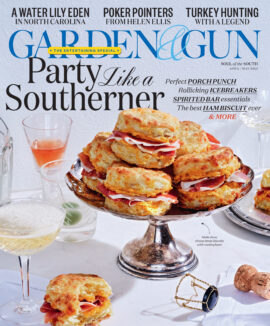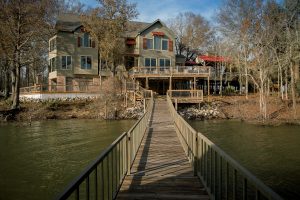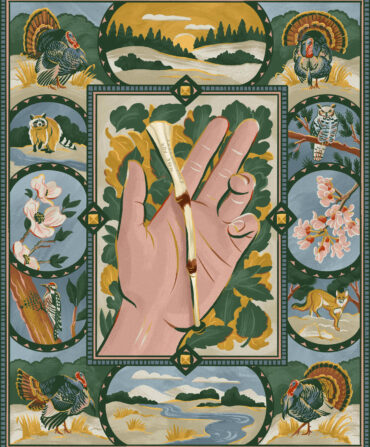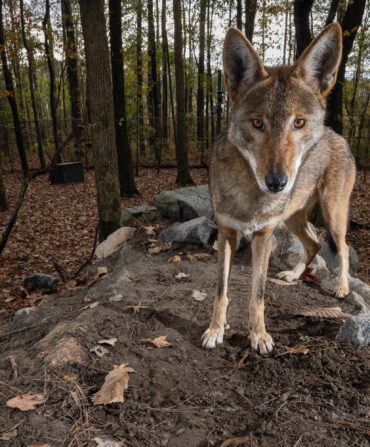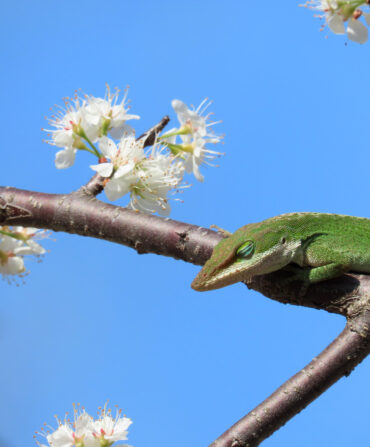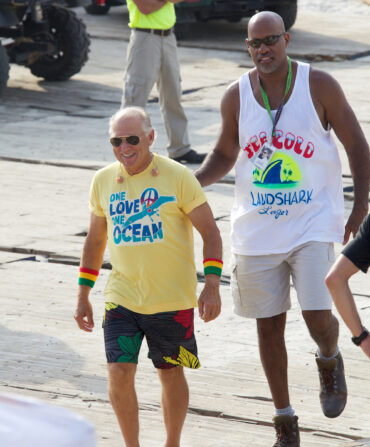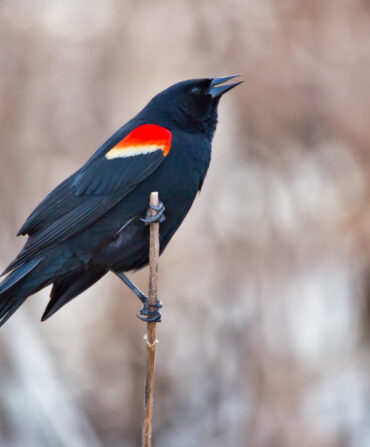Sporting
For the Love of Ducks
Deep in Louisiana duck country, a hunting lodge marries a conservation ethic with creature comforts
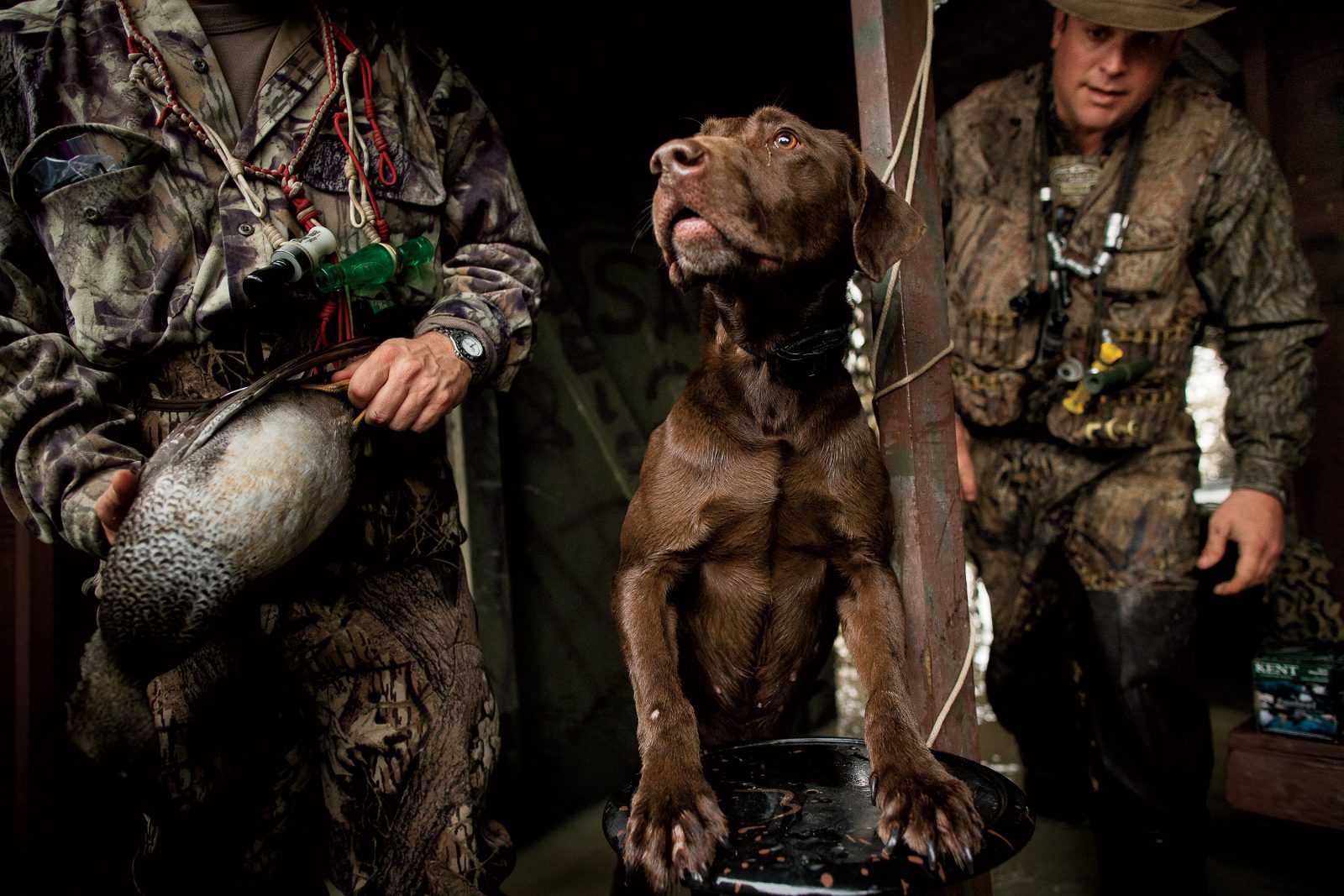
Photo: Rob Howard
Diesel, a chocolate labrador, takes a well-deserved break.
It’s a sip of coffee past sunrise in the central Louisiana wilds, where daylight seeps in slowly, rays of light spilling through trees, and John Burrell has his eyes on the ducks. “Way out there,” he whispers, and even in his hushed tones you can hear a Tennessee drawl. The birds are high, dark specks of pepper, just on the edge of worth it with a duck call, but we are only three ducks shy of a limit and guide Jared Mophett unleashes a hail call loud enough to split the earth. Two seconds later, the flock breaks off, banking hard. In two seconds more, they commit.
Burrell shakes his head and eases a hand to his shotgun. The ducks cup their wings three hundred yards high and fall like rocks. “Can you believe it?” he asks.
For the ducks, there is no hesitation, never a wing beat. They descend, bills into the wind, and now there are seven mallards back-flapping over the decoys, and guns are up and two birds drop with the first volley.
I shake my head. Those mallards could have dropped into any one of a million little sloughs or timber brakes across more than fifty square miles of Louisiana swamp and marsh and bayou. But this is exactly where they wanted to be.
I know the feeling.
Duck Paradise
Ducks have been piling into the Seven Rivers region of central Louisiana for untold centuries, but only in the last few years have any but local hunters been privy to the spectacle. That’s changing, thanks to the development of what could be the South’s most elegant duck hunting destination, Honey Brake Lodge. Situated on an 8,000-acre wetlands reserve, Honey Brake is a part of the 40,000-acre Louisiana Delta Plantation, a vast agricultural enterprise raising soybeans, milo, cotton, rice, corn, and wheat. Nearly surrounded by even more duck country in the form of federal and state public landholdings, the complex boasts access to pit blinds in rice fields, brushy hides in low marsh, and big timber blinds large enough for a half dozen hunters.
At one time, the entire 8,000 acres were in agricultural fields, but every square inch is now managed with wildlife in mind. Ducks Unlimited oversaw the design of 4,000 acres of shallow water impoundments—Honey Brake is the largest DU waterfowl project in the country—while nearly a half million trees were planted to provide food and cover. In a typical year, several thousand acres of Honey Brake are flooded in August, then drained the following
April. In the months in between, hundreds of thousands of mallards, pintail, teal, gadwall, and other ducks throng through the restoration project. Louisiana Delta Plantation provides so much habitat that federal and state wildlife agencies brought in additional pumps to flood an even greater area after Hurricane Katrina wrecked duck marshes along the Gulf of Mexico. The idea was to hold as many ducks and geese as possible in the area and keep the birds from moving to the soiled marshes to the south.

Photo: Rob Howard
The dock at Honey Brake.
And it’s not just the outdoors that sets this place apart. Honey Brake has taken the Southern duck camp to an entirely new level. The 13,000-square-foot lodge soars for four stories through the canopies of tall oaks and cypress trees. Elevated boardwalks connect the main lodge to three 1,800-square-foot cabins, half hidden by Spanish moss. Cantilevered over the shores of Larto Lake, one of Louisiana’s best crappie hot spots, the lodge decks are awash in sunshine, perfect for a long afternoon of doing nothing if the mood suits. That’s not likely, given Honey Brake’s gun club with fifteen-station and five-stand sporting clays ranges, a twenty-station archery range, and fishing boats on standby.
Spend a few moments indoors, and it’s as though Honey Brake’s designers conspired to convince you to never want to leave. Kicked back on a thick leather sofa, I glance around the lodge’s Grand Room. A table groans with soft-shell crabs, alligator bites, deep-fried crab claws, and shrimp dip. A four-sided fireplace is fronted with claw-footed overstuffed chairs. Everywhere there’s a wild mix of architectural styles and patinas, often shoulder to shoulder, but they all seem to express a common theme: grand and spacious and lofty, straining to match the sweep of landscape just outside.
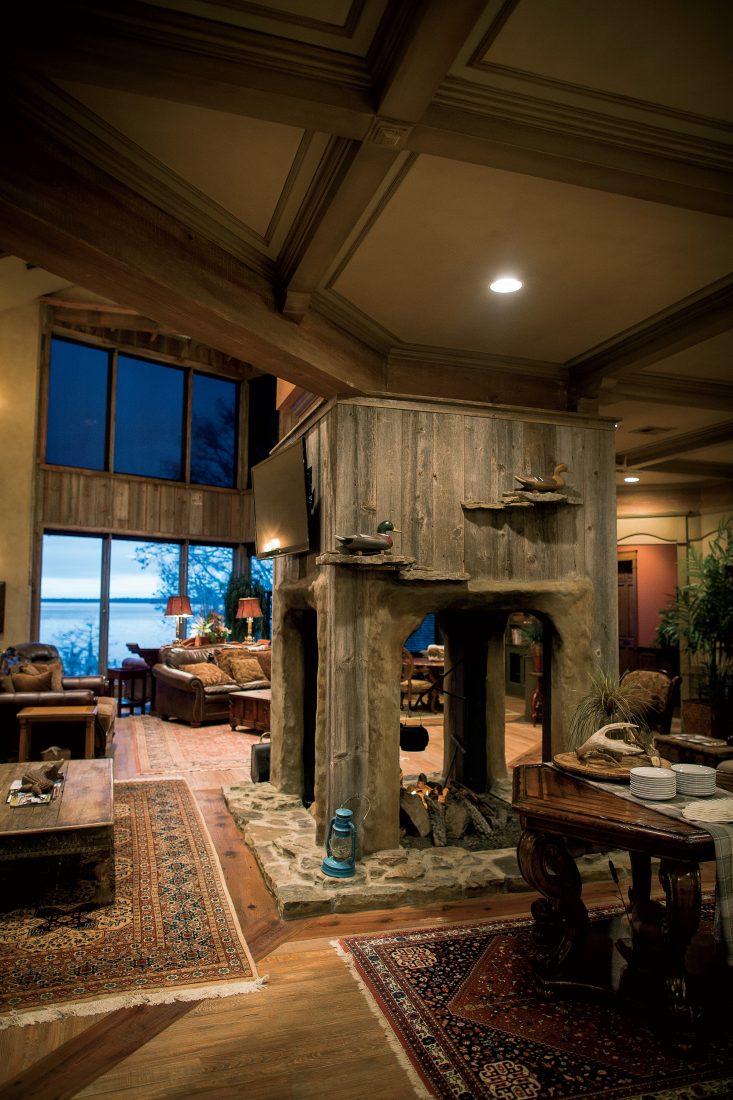
Photo: Rob Howard
A four-sided fireplace beckons in the lodge’s Grand Room.
It’s enough to make you nearly forget that this is a gunning lodge, but the reminders come every sunrise.
If anyone should know, it’s Burrell. At the grizzled old age of forty-three, he has emerged as one of the South’s leading sporting figures and one of the most sought-after outfitters in the world. His Atlanta-based High Adventure Company manages nearly a dozen of the finest hunting and fishing lodges in North America and Africa, and is the exclusive booking agent for a half dozen others. High Adventure owns and manages the Lodge at Tipiliuke in Patagonia, one of the premier trophy rainbow and brown trout and red stag destinations in the world. A sister outfit, S.A. Adventures, custom designs photo and ecotourism safaris in seven southern, central, and East African countries. When High Adventure Company was asked to define the Honey Brake experience, it was another heady opportunity for a small-town East Tennessee boy.
Born and raised in tiny Lake City, twenty-five miles north of Knoxville, Burrell “had a very traditional rural South upbringing,” he says. The son of a small-town doctor and a homemaker, he chased squirrels with a .410 shotgun until he went deer hunting for the first time at age eleven or twelve. “From the moment I stepped foot in the deer woods,” he says, “big game was it for me.” He couldn’t have known it then, but the seeds were planted for a lifetime of chasing some of the world’s largest, and most dangerous, game.
After graduating from Tennessee Tech University with a degree in wildlife biology, Burrell went to work a six-month stint at Georgia’s famed 4,500-acre Burnt Pine Plantation. He’d already accepted a graduate position for his master’s degree, but Burnt Pine’s owners were expanding into operations as far-flung as Zimbabwe and Argentina, and were sending guides to explore their new territories. At age twenty-four, Burrell made his first of more than thirty safaris to Africa. In 1998, when Mossy Oak kicked off its own global outfitting agency, the company tapped Burrell to head up the business. Some time later he bought out High Adventure Company and S.A. Adventures, and now finds himself in demand from enterprises as varied as Eddie Bauer, which asked him to help design the relaunch of its hard-core sporting line, to Beretta, which recently named him executive director of travel for its Trident Program of worldwide sporting destinations.
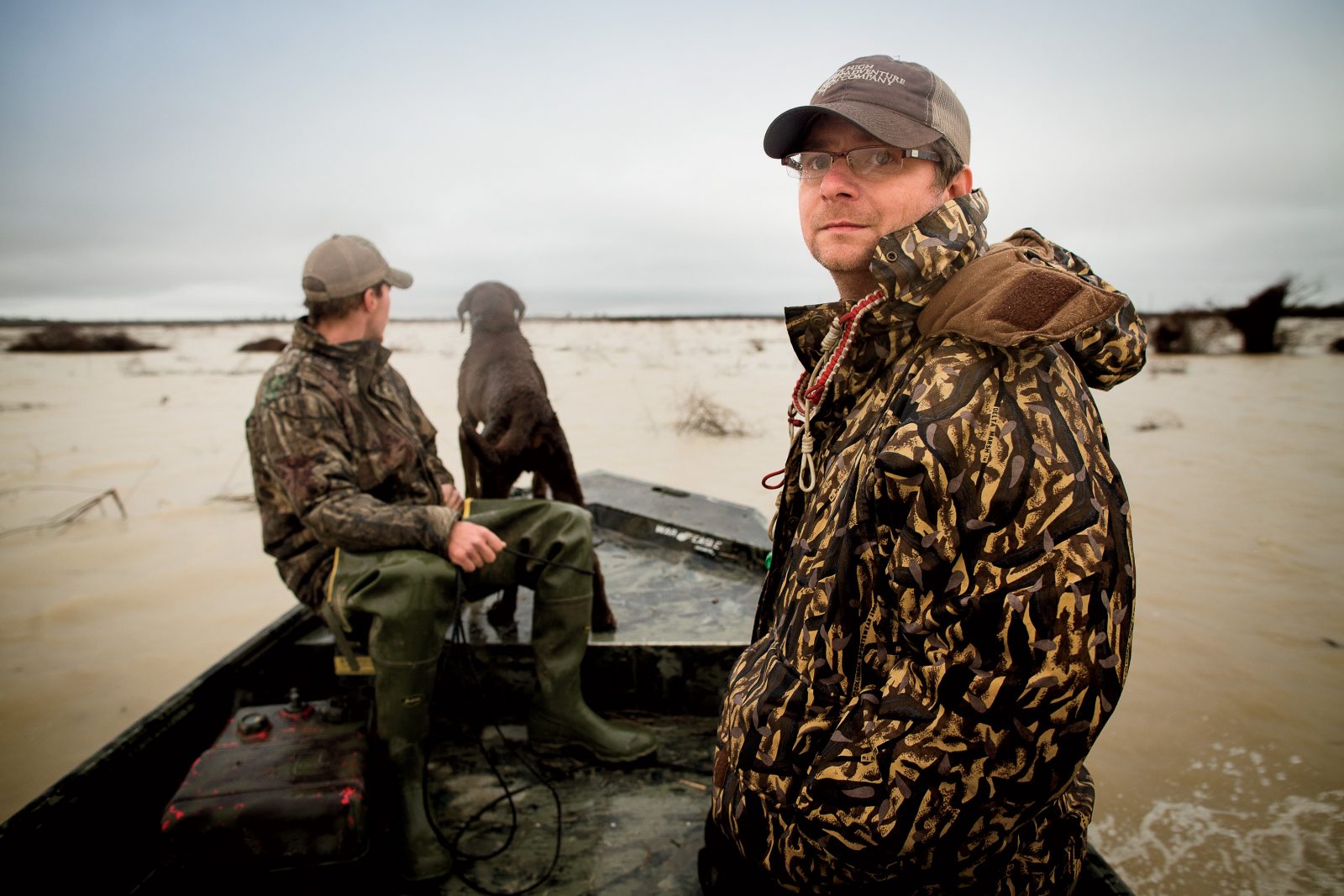
Photo: Rob Howard
John Burrell on his way to the blind.
All along, the place called Honey Brake had a grip on his heartstrings. “It’s amazing to me to see how my relationship with this place has come full circle,” Burrell says. In the late 1990s, Burrell began hunting Louisiana Delta Plantation with Cajuns he’d met at retriever competitions. Now, having the chance to fine-tune the adventure at one of his favorite places in the world is a thrill.
Eyes to the Sky
On my last morning’s hunt, Burrell, Honey Brake general manager Drew Keeth, and I motor in the dark across a remote shallow-water slough, then spread out in a spacious blind. In the daylight, the horizon is an endless sweep of marsh and scrub timber and water, unbroken in all directions. “The scale of this place is just enormous,” says Keeth, shaking his head despite the fact that he has plumbed nearly every acre of Honey Brake.
The possibilities for managing duck hunting are similarly impressive. Honey Brake guides and staff members scout every afternoon, sometimes by air. Of the 120 blinds available, perhaps three dozen are regularly hunted at any given time, with another 20 brushed and prepped for “run and gun” hunting, according to Keeth, if the birds show a liking for a particular slough or marsh. Each year, Honey Brake plants 2,000 to 3,000 acres just for wildlife, and the resources of a vast agricultural enterprise can be brought to bear for waterfowl. You need to put out a half mile of polypropylene pipe to flood a duck field? Done. “It’s a chess match,” Keeth says. “We figure out where the ducks want to be, and then we do whatever we have to do to be there.”

Photo: Rob Howard
Burrell takes aim at incoming birds.
And the scope is expanding. This year, Honey Brake plans to offer limited hunts for white-tailed deer. In the last six years, only six bucks have been taken off the property, and the largest posted Boone and Crockett numbers between 170 and an eye-popping 236. In recent weeks, a new youth camp facility was finished and made ready for summer camps designed around shooting, fishing, and conservation.
But the centerpiece of the Honey Brake experience will continue to be moments like this. Keeth wears a camouflage vest stuffed with 12-gauge shells and a fully brimmed McAlister hat. His call lanyard is freighted with calls—pintail and teal whistle, mallard drake call, specklebelly goose call, and mallard hen calls for big water and close-up work. The dawn flight is slow, but as the sun breaks free of early clouds, the ducks are on the feed, and Keeth and Burrell put on a tag-team calling exhibition that some of the birds simply can’t resist.
The early morning’s wads of eight and ten and twelve cartwheeling ducks turn into flocks of thirty and Vs of fifty—high birds, but workable, and we knock down the occasional teal and gadwall. Then a small group of big ducks banks over the slough a hundred yards out, and the Keeth and Burrell show of two-man quacks and hail calls pays off. When one of the ducks quacks back, we know we have them, but they’re not finished messing with our minds. The birds are behind us now, lost in the brush, but we know they’re up there, and Keeth switches to a quiet little mallard drake call, a quirky little qwerrp-qwerrp buzz that can finish a duck like catnip. We keep our heads down, daring just the occasional peek at the sky, grown men hiding from birds behind the brims of our caps.
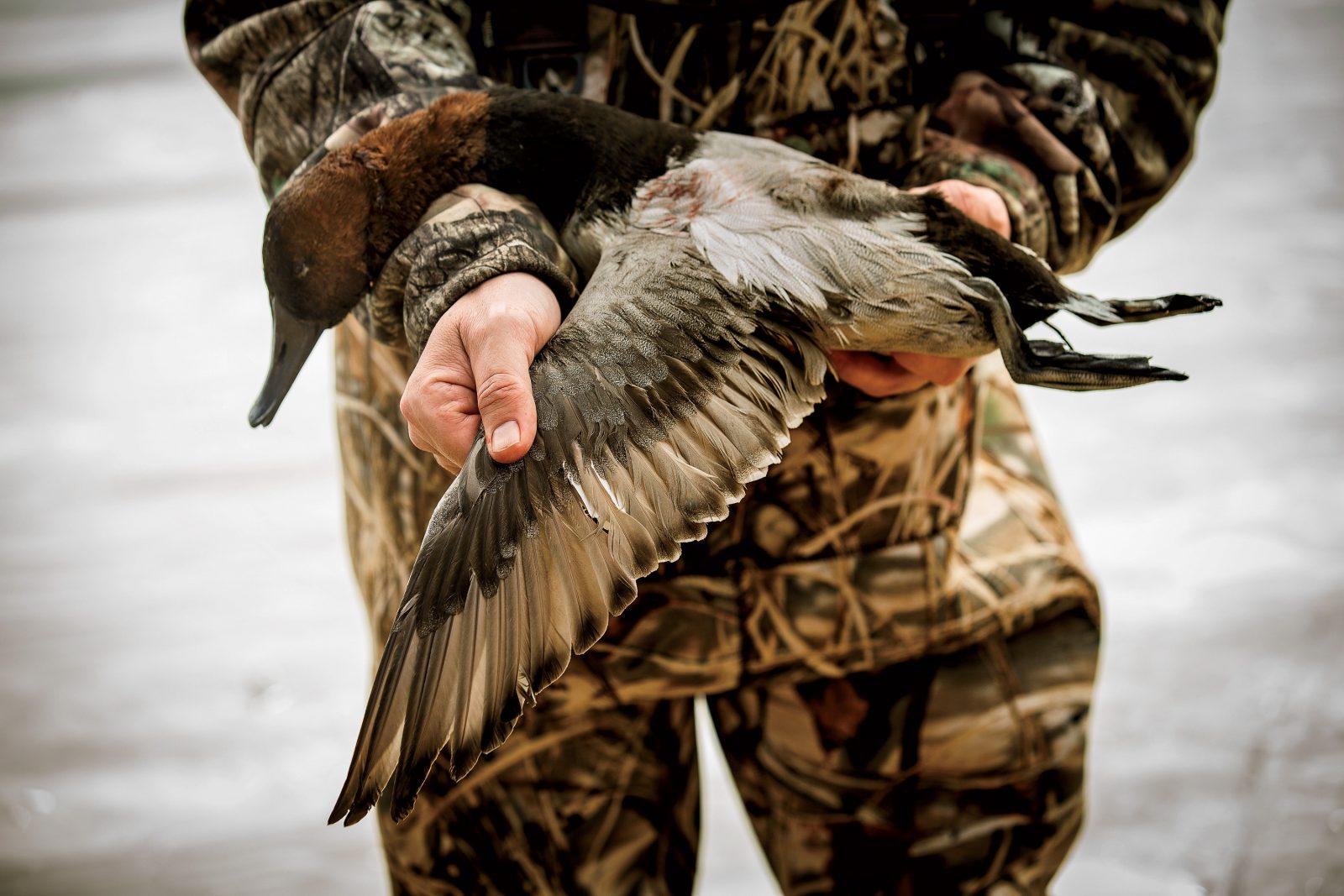
Photo: Rob Howard
Wing Men
A duck in hand.
The ducks cut the corner of the blind and suddenly appear over the decoys, three mallards with wings cupped. There’s no time to think it through or call the shot, just barely enough time to get the guns up and shouldered and triggers pulled.
Two of the ducks tumble while a third claws for daylight. After the high fives and attaboys, we reload and settle down, turning our gaze back to the panorama of sky and marsh and water. The blind grows silent for a moment, then Keeth breaks the spell with a Louisiana benediction.
“Just look out there,” he murmurs. “Greenheads in the decoys. If there’s any place prettier in this world, I don’t want to hear about it.”
Photo: Rob Howard
Diesel eagerly awaits the next retrieve.
1 of 7
Photo: Rob Howard
A group of hunters gather to compare notes.
2 of 7
Photo: Rob Howard
Hunters watch the skies for birds.
3 of 7
Photo: Rob Howard
A lanyard full of duck calls and leg bands.
4 of 7
Photo: Rob Howard
A fine over-and-under at the ready.
5 of 7
Photo: Rob Howard
In Deep
Drew Keeth makes his way to a decoy.
6 of 7
Photo: Rob Howard
A duck strap heavy with the morning’s take.
7 of 7

